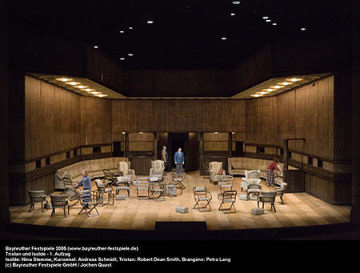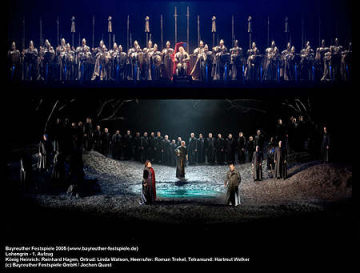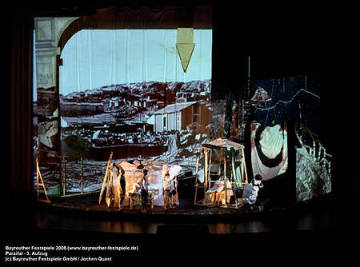|
Editor: Marc Bridle
Webmaster: Len Mullenger
|
Seen and Heard International
Opera Festival Review
2005 BAYREUTH FESTIVAL: Tristan
und Isolde, Lohengrin
and Parsifal; Soloists, Bayreuth Festival Chorus
and Orchestra, Festspielhaus, Bayreuth, Germany, 25th
– 29th July, 2005 (SM)
Director: Christoph
Marthaler. Set and costumes:
Anna Viebrock. Tristan: Robert
Dean Smith Isolde: Nina Stemme Brangäne: Petra
Lang King Marke: Kwangchul
Youn Kurwenal: Andreas
Schmidt Melot: Alexander
Marco-Burhmeister
Director: Keith
Warner Sets: Stefanos Lazaridis Costumes: Sue Blane Lohengrin: Peter
Seiffert Elsa: Petra-Maria
Schnitzer King Heinrich: Reinhard
Hagen Telramund: Hartmut
Welker Ortrud: Linda Watson Heerrufer: Roman
Trekel
Director: Christoph
Schlingensief Sets: Daniel Angermayr,
Thomas Goerge Costumes: Tabea
Braun Parsifal: Alfons
Eberz Amfortas: Alexander
Marco-Burhmeister Titurel: Kwangchul
Youn Gurnemanz: Robert
Holl Klingsor: John Wegner Kundry: Michelle
De Young
The
94th outing of the Richard Wagner Festspiele was one of those
Ring-free years, where the old production
of the sprawling tetralogy has already been put to bed, while
the new one is still in the making.
So, this year, five operas were on the bill -- Tristan und Isolde in a brand-new production by Swiss theatre director
Christoph Marthaler; and successive revivals of Keith Warner's
Lohengrin; Claus Guth's Der fliegende Holländer, Philippe Arlaud's
Tannhäuser and Christoph
Schlingensief's Parsifal.
It was Marthaler's Tristan that opened the festival on Monday July 25th. The first new production of the opera in six years -- since Heiner Mueller's critically acclaimed staging that closed in 1999 -- and only the 10th in the festival's history, the rather dour and obtuse reading sadly failed to live up to expectations. For Marthaler, Tristan and Isolde's ill-fated passion is like a flame that flares up briefly and is then extinguished forever. But his clinical, dispassionate dissection of that passion rendered it possibly the coldest I've ever seen.
Only for one brief
moment in "Sink hernieder! Nacht der Liebe" is there
a frisson of eroticism as Tristan coyly nestles his head in
Isolde's lap and gently pulls off her elbow-length gloves. Apart
from that, the unhappy lovers do not touch at all. In fact,
their passion is depressingly destructive, leaving not only
Tristan and Isolde high and dry in their inability to communicate,
but also severing the ties between Brangäne, King Marke, Kurwenal
and Melot, who in the end are left scrabbling in autistic isolation. Anna
Viebrock's spare, minimalistic sets only increased the feeling
of loneliness. Act I
could have been a saloon on an old, dilapidated ocean liner,
a deserted lobby of a run-down hotel or the wood-panelled waiting
room of a train station. Act II
is the same building one floor down, in what appears to be an
empty ballroom with mustard yellow wallpaper, a worn parquet
floor and two single Le Corbusier seats.
And Act III takes place one floor down again, this time
in the cellar with bare unplastered walls. The other levels
are still visible above, with simply the floors taken out.
In the title role,
German tenor Peter Seiffert received standing ovations, his
clarion-clear "Heldentenor" standing out in a generally
mixed performance by the rest of the cast. His real-life partner,
soprano Petra-Maria Schnitzer, sounded shrill and forced as
Elsa in Act I, and failed to convince in the subsequent two
acts as well, with her thin, one-dimensional singing and acting.
US soprano Linda Watson, tipped to be Brünnhilde in Bayreuth's
new Ring next year,
sang the role of the wicked power-hungry Ortrud with an unpleasant
wobble.Reinhard Hagen as King Heinrich, Hartmut Welker as Telramund
and Roman Trekel as the Heerrufer were all unexpectional.
It was the first
revival of Schlingensief's staging of Richard Wagner's final
opera, with its dizzying, bewildering flood of visuals, since
it was premiered in 2004. And although Schlingensief has cut
the copious use of video, his voodoo-ridden reading still infuriates,
with its complete absence of narrative structure and the main
characters reduced to mere chiffres. The stage
remains a cluttered, confusing junkyard of a Moor's palace,
African huts, and refugee camps complete with electrified fences
and prison watchtowers. And the use of doubles for Parsifal and
Kundry only adds to the perplexion. Among the constantly recurring video images projected
onto screens and across the entire stage was a blossoming flower
and a time-relapse film of a rotting rabbit cadaver.
Simon Morgan Photographs © Bayreuth
Festival, 2005
Back to the Top Back to the Index Page |
| ||
|
||||





